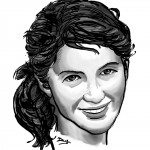Every year, the Golden family reunites to celebrate Passover, as some subset of our family has for more than 70 years. For two nights, we eat, drink and sing songs extraordinarily off-key, and I begin the long, drawn-out process of living on unleavened bread that tastes like cardboard for over a week.
 When I was little, Passover was my favorite holiday: I loved seeing my cousins, with whom I wrote and performed a series of Passover plays, and I enjoyed my grandmother’s matzo ball soup. Because I was young, I overlooked the tension that inevitably comes when three generations of Jews with complicated relationships with their faith and to each other spend time under the same roof. Now, I live those complications, and it is both harder and more important to celebrate Passover because of them.
When I was little, Passover was my favorite holiday: I loved seeing my cousins, with whom I wrote and performed a series of Passover plays, and I enjoyed my grandmother’s matzo ball soup. Because I was young, I overlooked the tension that inevitably comes when three generations of Jews with complicated relationships with their faith and to each other spend time under the same roof. Now, I live those complications, and it is both harder and more important to celebrate Passover because of them.
The source of some of this tension is the fact that my father and his two brothers married non-Jewish women, though all three brothers raised their children as Jews. While there’s a wide spectrum of belief amongst us (my brother is an atheist, though don’t tell my grandfather), we all toe the line in public. Passover is our concession to our Jewish identity. We celebrate it for our grandparents, who are much-beloved and aging, and for our fathers, who left home and don’t go back often.
The story of my family’s Passover reunion is not unlike the story of many other Jews in the United States and around the world: the ritual of holding Seders, epic meals at which we tell the story of the Exodus from Egypt, is a collective action that reminds Jews of how ancient the religion is. Jews hold Seders on the same two nights; for the same eight days, we all eat unleavened bread; at the end of every Seder, we all wish each other “Next year in Jerusalem,” a return to the Holy Land. Together, Jews become ritual-makers and storytellers remembering past suffering and praying for a better future. We are connected to each other and to Jews throughout all of history.
At the same time as the Seder enacts tradition, it also represents the possibility for innovation. In the center of every Seder table is the Seder plate, on which the most sacred symbols of the holiday are placed. In the last few decades, additional symbols have been added to the plate in the wake of feminist, LGBT and peace advocacy: a cup to represent the importance of Moses’ sister, Miriam, in the Passover story; an orange to celebrate the fact that women and the LGBT community can now participate fully in many forms of Judaism; and, in some cases, an olive branch, which acknowledges the suffering of Palestinians in the Middle East and the hope for peace in the region. Over the last many years, our family added first Miriam’s cup, then the orange, though we have yet to add the olive branch, partially because my grandparents are self-proclaimed Zionists who avoid discussing the realities of life in Palestine.
This final symbol — the olive branch — is a potent symbol of the ways in which my relationship to the holiday has changed since childhood. After years of working at a conflict resolution camp for Israelis and Palestinians, I have made the symbolic olive branches central to my life. At the same time, I know from more than 20 years of attending Seders how challenging the inclusion of the branch would be for my grandparents. Even as the Seder represents the possibility for maintaining traditions and holding families and communities together over time, the very symbols that define the tradition can become problematic, contentious and subject to different interpretations. We can love the holiday — and our families — while also struggling to reconcile what we believe with what they believe and what they want from us.
This year, I am hosting my first Seder for friends at Yale. If I can find an olive branch in time, we’ll put it on our Seder plate. In the future, I’ll try to balance the person I am expected to be at our family’s Seder with the person I am becoming at my own. Next year, almost certainly not in Jerusalem, I hope I’ll be brave enough to have a real conversation with my grandparents about symbols and traditions. The beauty of Passover is that it’s been around a long time — and we all get to be part of its perpetual reinvention.
Zoe Mercer-Golden is a senior in Davenport College. Her column runs on alternate Tuesdays. Contact her at zoe.mercer-golden@yale.edu .







